See how brilliant it is! As you know, this is Kinkakuji temple (金閣寺, Temple of the Golden Pavilion), which is one of the most worldwide attractive sights. Most tourists will visit this temple while in Kyoto and must be struck by the beauty.
However, this temple doesn’t only show us its splendor here. I can’t help feeling that it’s telling us something behind the charm.
There’s no doubt that a little more knowledge about this temple would arouse your interest in it. I’ll share how to enjoy Kinkakuji 10 times more!
For common information about this temple, please click the link at the end of this blog. I tried to avoid overlapping the contents of this article with the official site as much as possible.
Mt. Daimonji (大文字山)
There’s something I’d like you to take a look at before visiting Kinkakuji. It has nothing to do with the temple, though.
Look up diagonally right at the point about 20 to 30 meters ahead of the gate. It’s Mt. Hidari-Daimonji. You can see a kanji character “大,” which means “big,” on the hill. We have an annual fire event called Daimonji or Gozan-no-okuribi on August 16th.
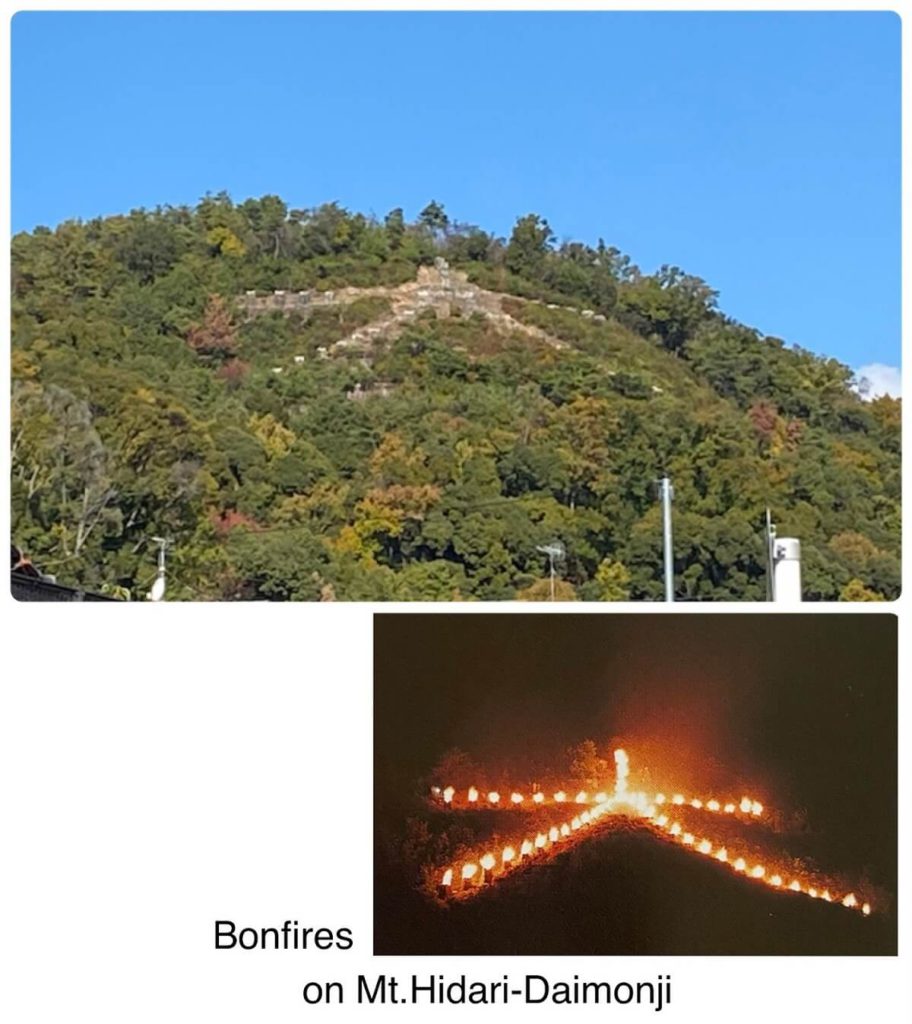
It’s no exaggeration that Kyoto city has strict rules about building height so that we can see the bonfires from anywhere in Kyoto city held on only one day a year. This is our way of preserving tradition.
Gozan no okuribi
https://www.discoverkyoto.com/event-calendar/august/daimonji-gozan-okuribi-ritual-fires/
= Kinkakuji =
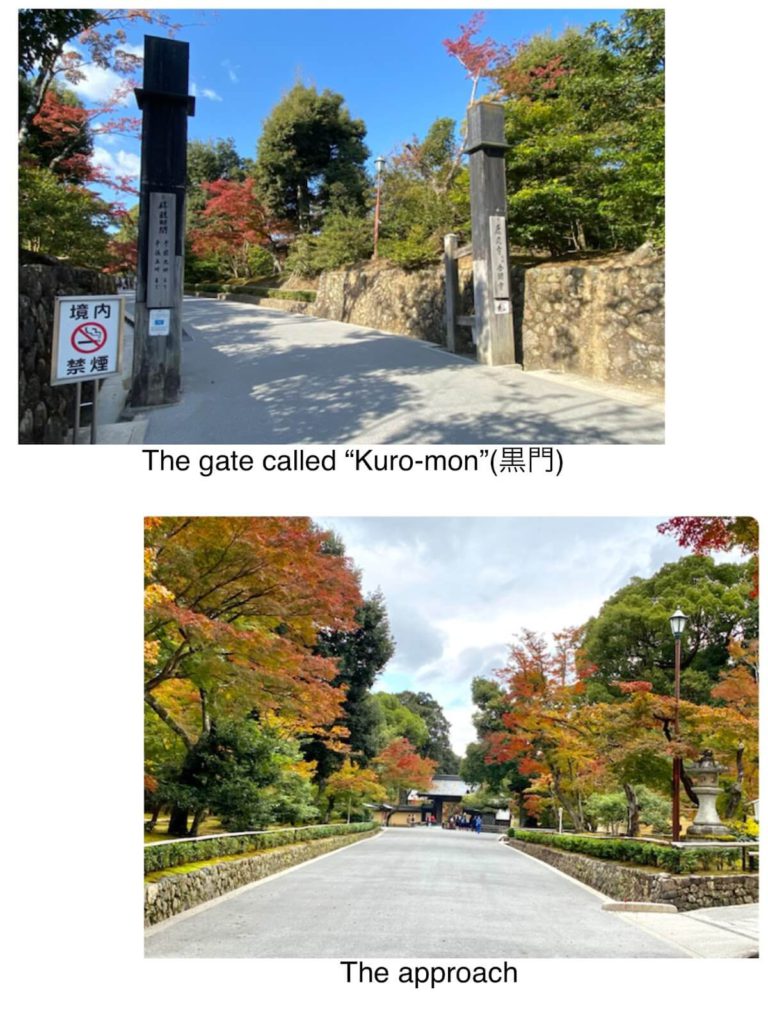

Can you see these 5 white lines on the wall? Temples with 5 white lines on their walls are considered the most prestigious ones, followed by temples with 4 and 3 lines on their walls.
After passing through the main gate, the route is one-way. I’ll introduce each spot in order.
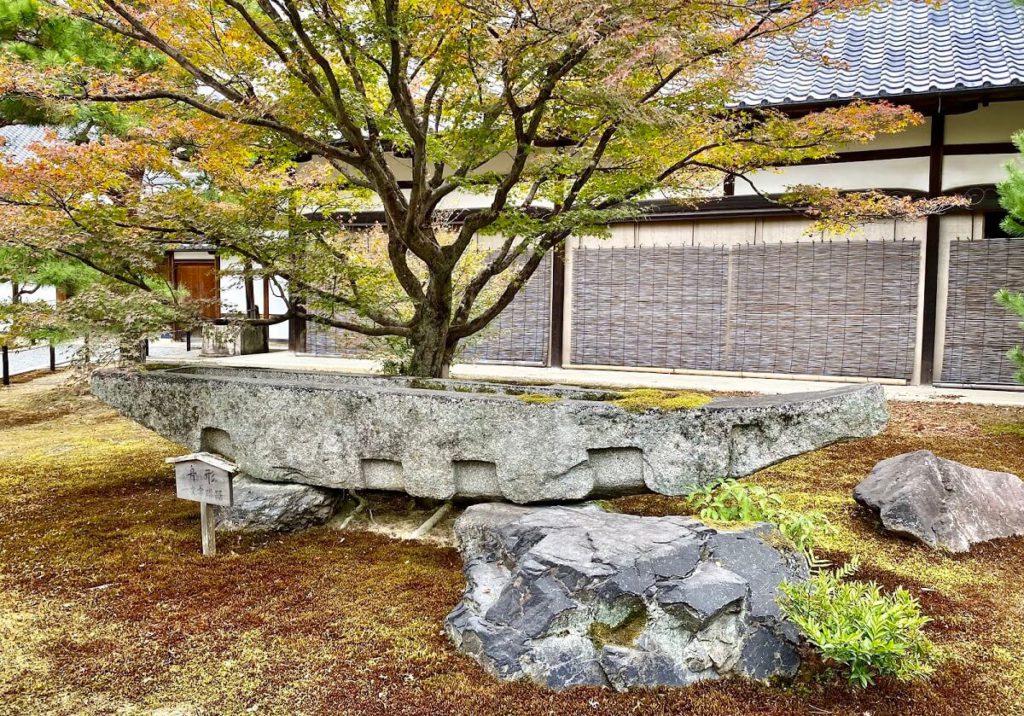
First of all, we can see a boat-shaped washbasin on our right. It used to be a watering place for horses.
Next, Bell Tower is on our left.
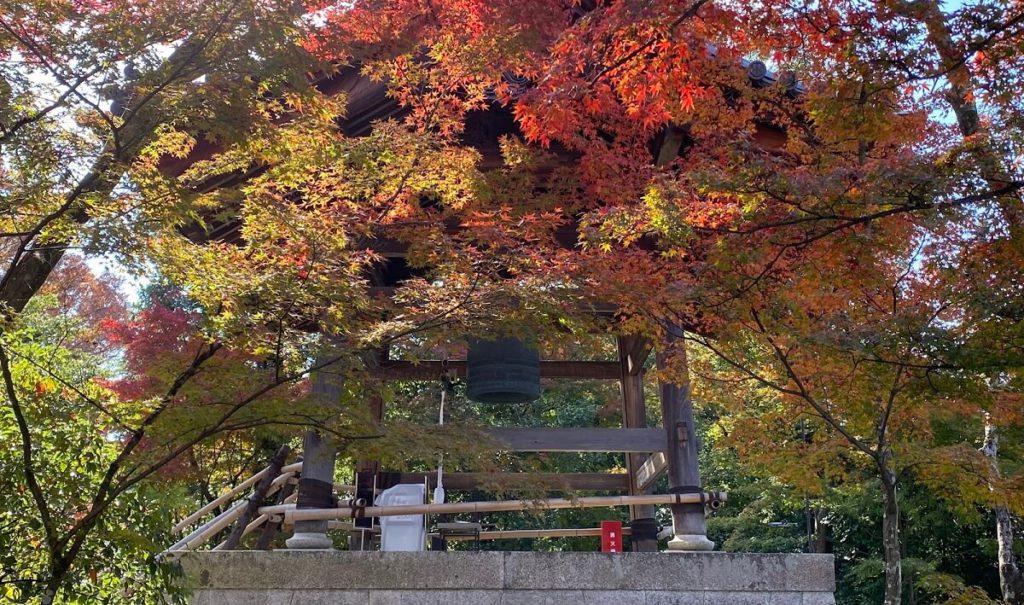
Most big temples have Bell Towers like this. On New Year’s Eve, we ring the bell 108 times. It is thought that we human beings have 108 worldly sins in Buddhism. So, we strike the bell 108 times at the end of the old year to get rid of these worldly desires and welcome the new year, which is called Joya-no-Kane (除夜の鐘).
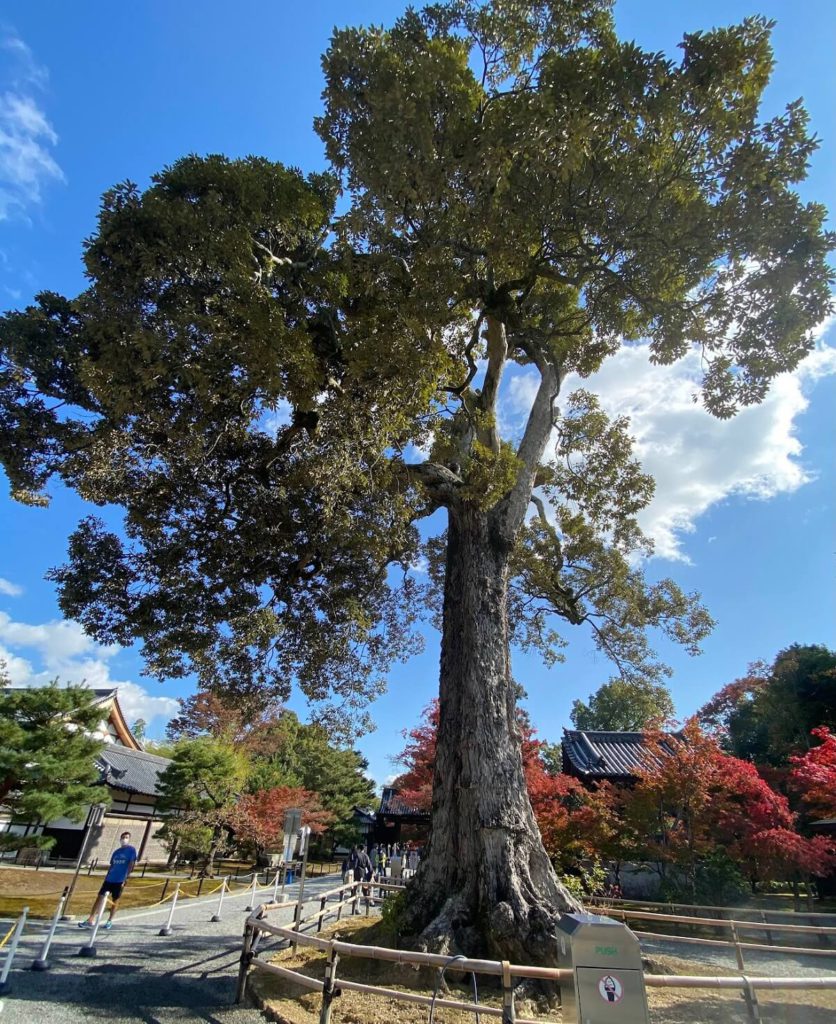
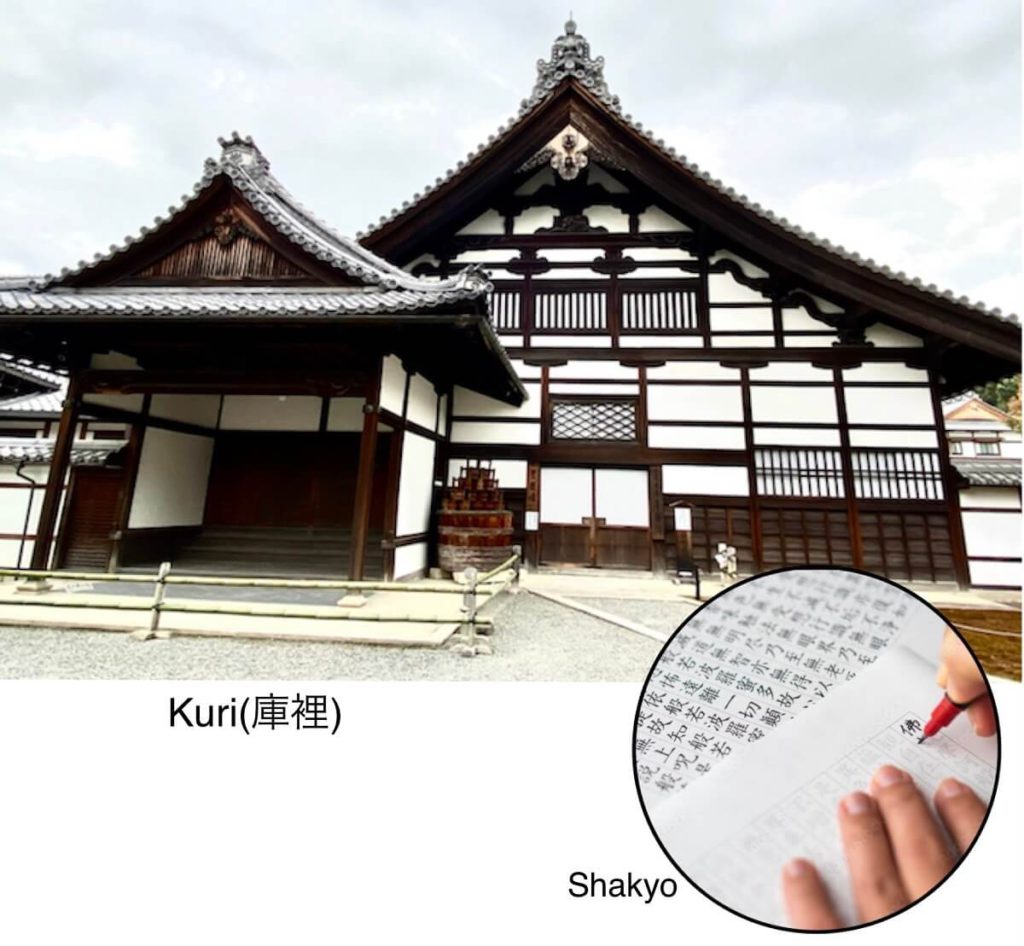
This is a building called Kuri, which used to be a kitchen, where we can now experience Sutra copying (写経, Shakyo).
Shakyo
https://www.sotozen.com/eng/practice/sutra/shakyo.html
Kuri is on our right just before the ticket office.
The picture below is an admission ticket. You can keep this as a good luck talisman. We usually put it over the entrance door. Then, it will bring happiness to our families.
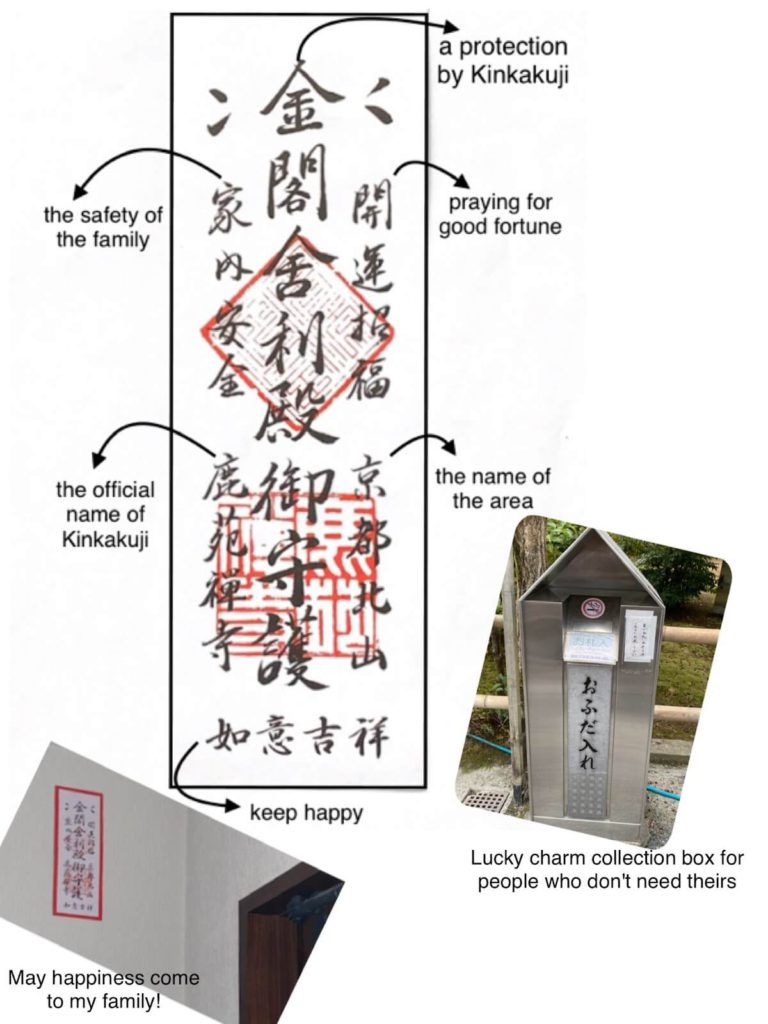
☆Shari-den (舎利殿, Kinkaku)

~ the history ~
To explain it in briefly, this building was built by Ashikaga Yoshimitsu (足利義満), who was the third shogun of the Muromachi shogunate, in 1397. It was originally his retirement villa. According to his will, it turned into a Zen temple of the Rinzai sect officially called Rokuon-ji (鹿苑寺) after his death.
The present building was reconstructed in 1955. The original one was set on fire by a 21-year-old novice monk training at this temple in 1950.
~ the structure ~
As you can see, the building consists of three floors. Each floor represents a different type of architecture. The first floor was modeled on a house of Emperor and Heian Era nobility. And the only first floor is not covered in gold leaf. The second floor was built in the style of samurai warrior’s houses. The third floor is in the Zen temple style.
Hmm, there’s something meaningful about the building structure! Can you imagine what Yoshimitsu alluded to?
We’d say, in a nutshell, the lowest floor uncovered with gold symbolizes the aristocracy, the middle floor represents the samurai, and the top floor implies Yoshimitsu himself. He had already become a monk two years before he built Kinkakuji. Or, some think the third floor would imply China because it has the Chinese Zen Hall style in honor of the Ming dynasty.
Anyway, Yoshimitsu built this gorgeous building to show off his power to people not only in Japan but also in China. He also welcomed important guests from China to this building as well. Actually, he succeeded in restarting trade with China about 500 years after we stopped the trade in 894. It goes without saying that he gained a large profit from the trade.
Unfortunately, we are not allowed to enter the building. We can only see the interior of the first floor over the pond.
The phoenix (鳳凰, Ho-o) is on the top of the roof. It’s a symbol of rebirth and happiness as well in Japan. Yoshimitsu might’ve wanted to say that it is himself.
☆Garden
It’s said that if you don’t see the garden of Kinkakuji, you can’t really claim, “I saw gardens in Kyoto.” The garden here is just that splendid.

This pond is called Kyokochi (鏡湖池), which literally means “Mirror Pond.” We can see an upside-down Golden Pavilion in the pond.
There are also several islands in this pond. The biggest one, called Ashihara-jima (葦原島), symbolizes Japan. Yoshimitsu even made the Japan island here. He must’ve been satisfied with saying,” Now I can control all over Japan,” looking down at the Japan island from the third floor or going around it in a boat.
Try to look for the turtle island and the crane island. The crane and the turtle are symbols of longevity as there’s a proverb in Japan, “ A crane lives for 1,000 years, and a turtle 10,000.”
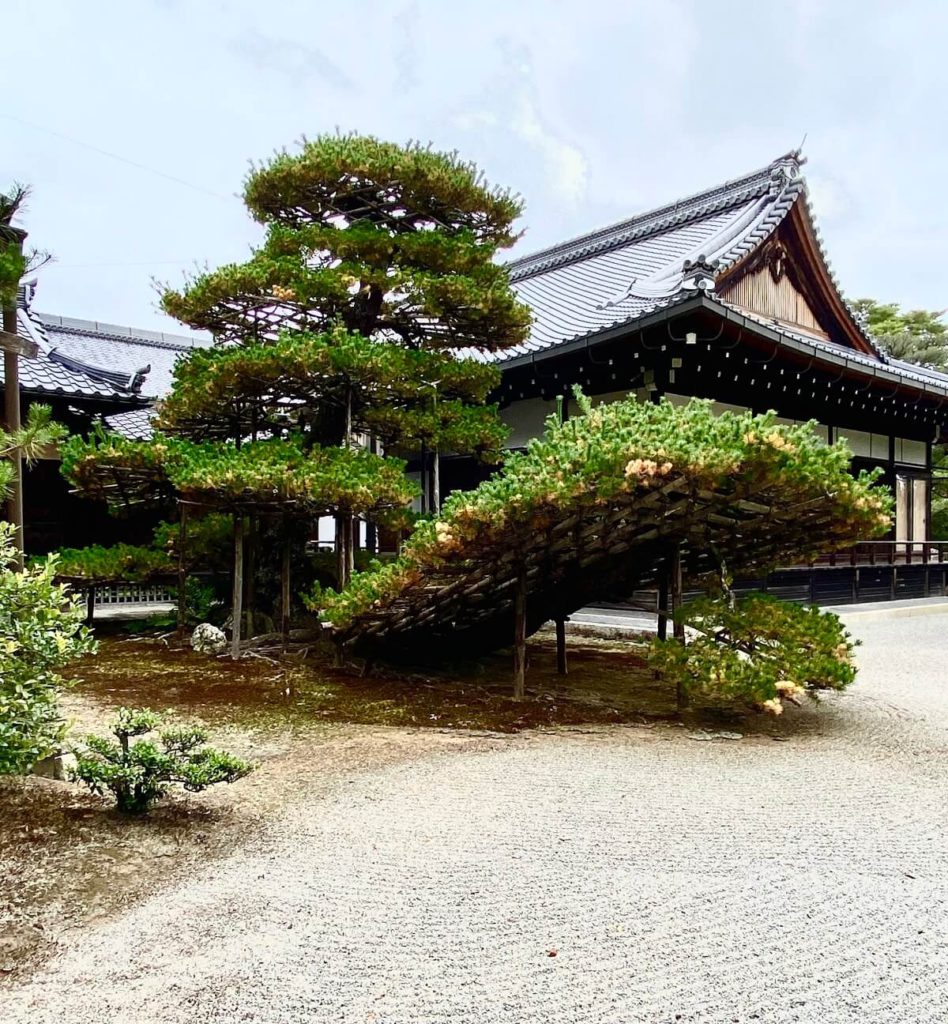
This pine tree was originally Yoshimitsu’s beloved bonsai (盆栽), and he planted it here more than 600 years ago.
What shape do you think this pine tree looks like? It looks like a boat, doesn’t it? And the raked gravel waves on the ground, which we call samon (砂紋), represents water or the ocean. In fact, this boat faces west because it’s thought that there is Paradise in the west in Buddhism. So, it’s about to sail for the west, or Pure Land!

Ginga-sen (銀河泉) literally means Galaxy Spring. It’s said that Yoshimitsu used this water when he made tea, and also he purified his hands here, Genka-sui (厳下水), for tea ceremony.

Here’s Ryumon-no-Taki (龍門の滝), meaning Dragon’s gate waterfall. That stone is called Rigyo-seki (鯉魚石, Carp stone). Don’t you think it looks like a carp? Now it’s swimming up the waterfall. In a story from a Chinese legend, a carp transforms into a dragon after climbing up a waterfall. It means you will leap straight to the top!
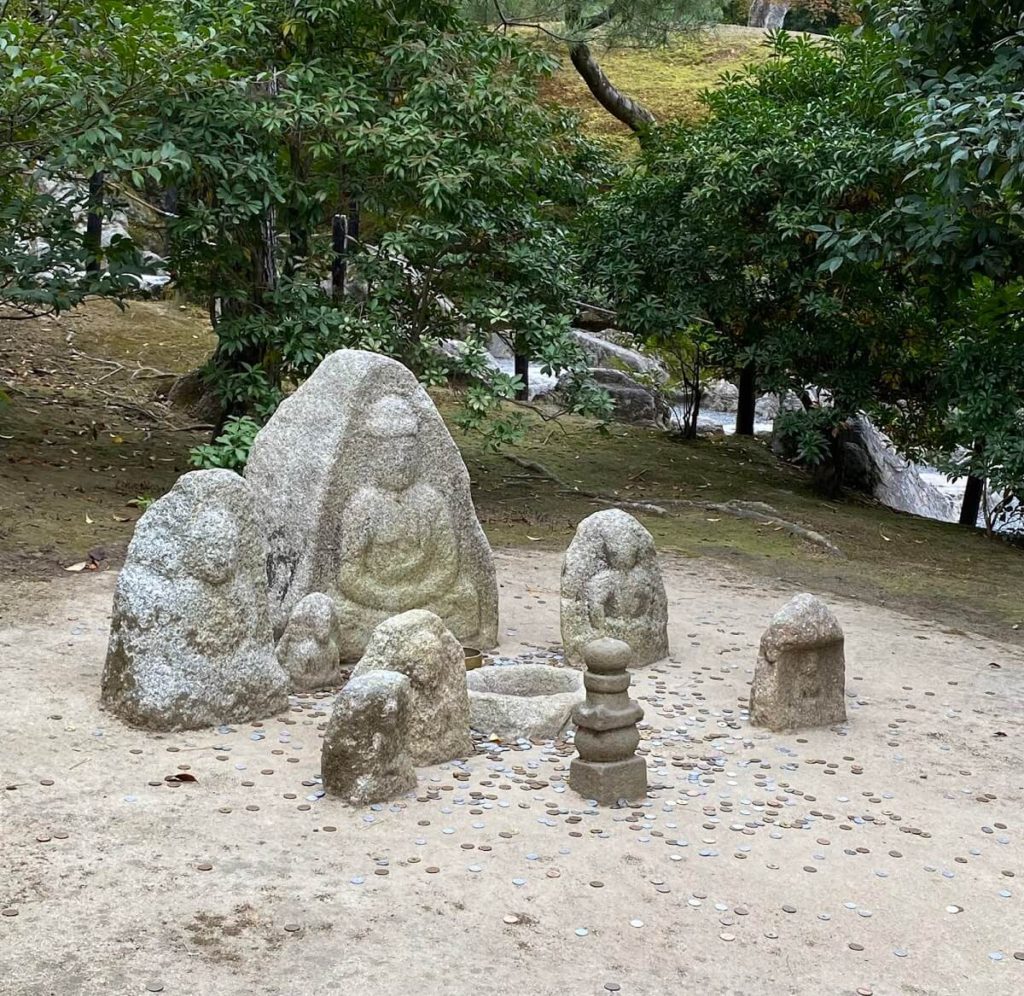
Here are some stone statues and a stone bowl in the center. Visitors try to throw a coin into the bowl. Just give it a try with a one-yen coin, which is the most difficult to control.
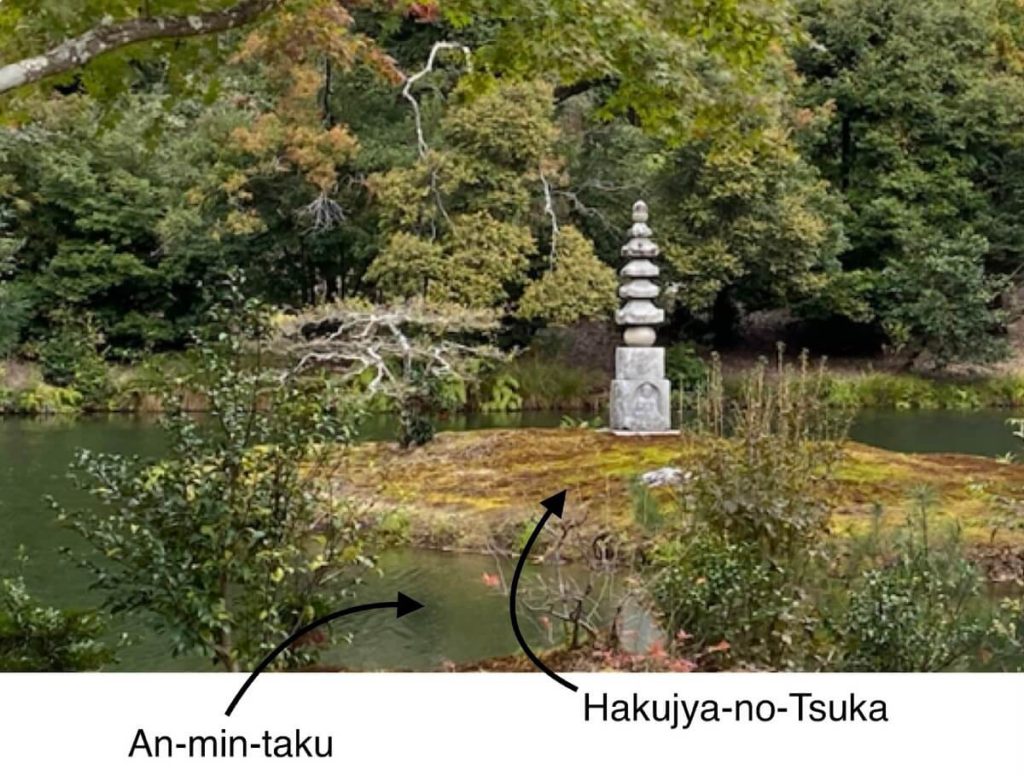
It’s called Hakujya-no-Tsuka (白蛇の塚), which means “White snake mound.” A white snake has been enshrined there. And it’s said that the white snake is a god of water. Actually, this pond called An-min-taku (安民沢) has never dried up thanks to the white snake.
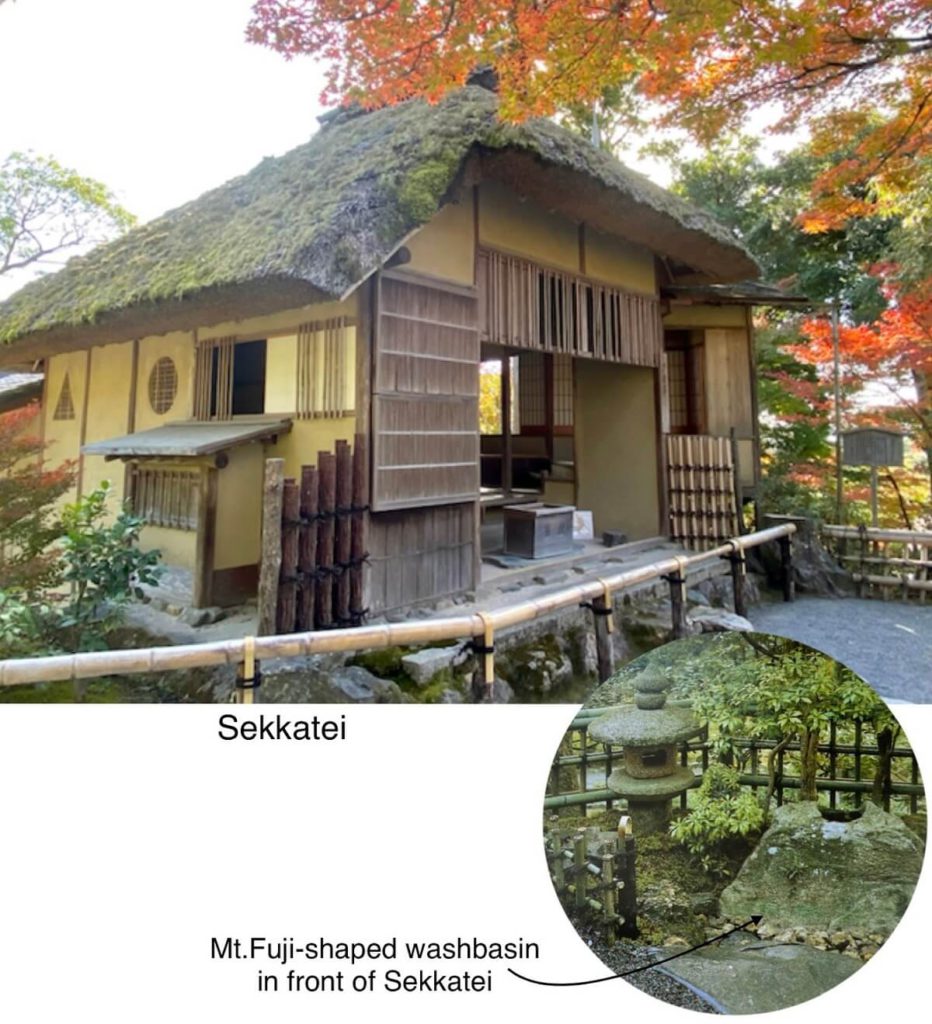
This is a teahouse with a thatched roof called Sekka-tei (夕佳亭), which means “Beautiful Teahouse in the Evening.” This is the best place to see the brightening Golden Pavilion at sunset.
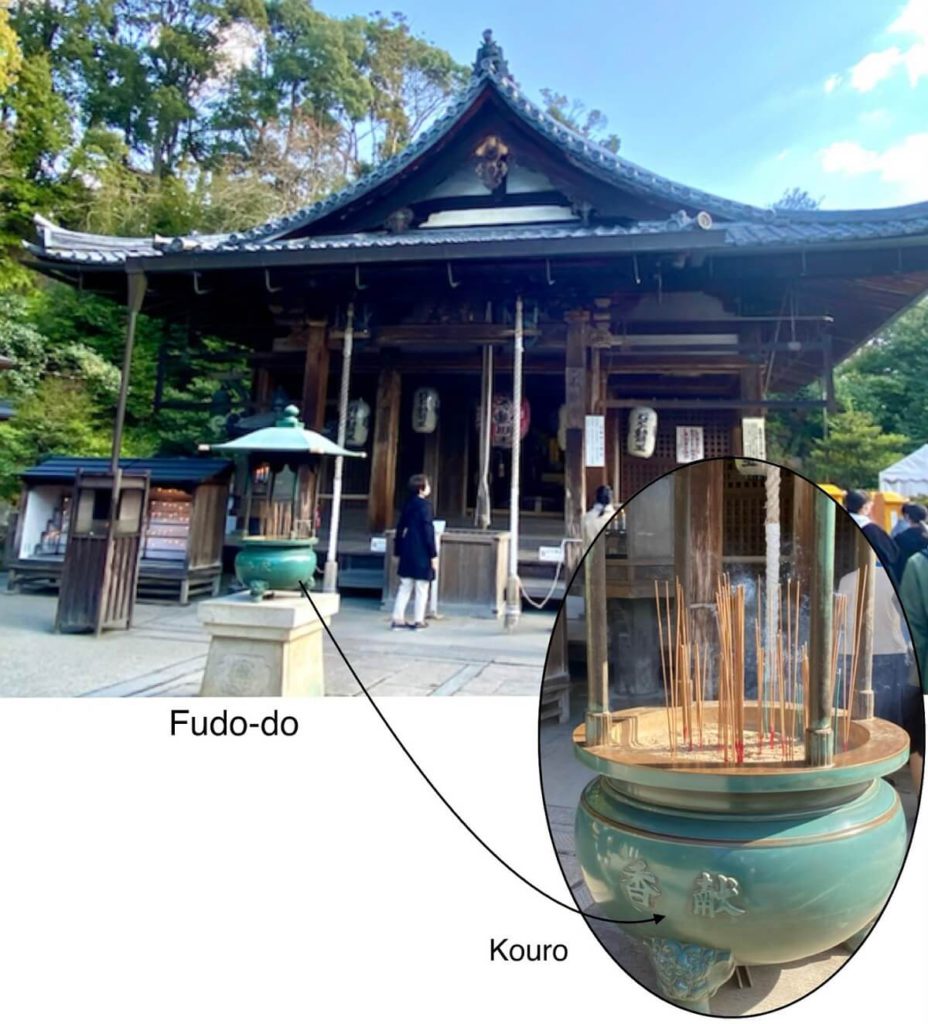
This is a temple called Fudo-do (不動堂). The stone Fudo-myo-o (不動明王) is enshrined here.
Kouro (香炉) means an incense burner. If you have some injuries or pain in your body, you might as well try to fan the smoke from incense sticks onto the parts you want to heal. It’s believed the smoke will ease the pain and you will feel better.
Now you know that Kinkakuji is not only famous for its shining building, but also the paradise where Yoshimitsu put his thoughts into the buildings, the garden and everywhere.
I’d like to think that this article helps you enjoy Kinkakuji 10 times more.
Kinkakuji
https://www.shokoku-ji.jp/en/kinkakuji/
Born and raised in Kyoto. A private tutor and a volunteer tour guide in Kyoto. Love sewing, kimono remaking, traveling, cooking, gardening, playing the shamisen(三味線), making stained glass and grandparenting as well.


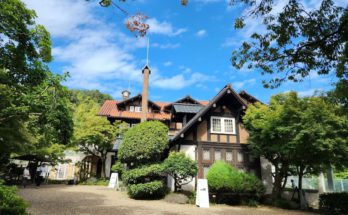
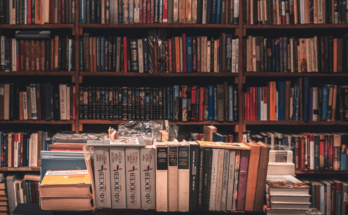
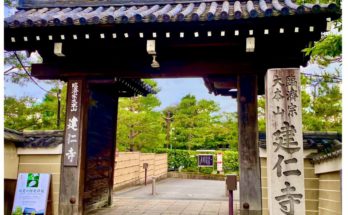
 HTJ has a YouTube page! Check it out
HTJ has a YouTube page! Check it out
Rieko san!
Really practical guide and beautiful pictures.
Best giude book of Kinkakuji I’ve ever met!
Thank you for your comment! We haven’t had any guests from abroad since last year, right? So, I wrote this blog with the intention of being guiding my guests.
Rieko,
Great article- very informative with thr nice pictures. I remember that hot day in May 2017 when you brought us there to show the Golden Pavilion! I think it was the most beautiful place i ever seen! I hope I will see it again with you.
Hi Irena,
Thank you for reading my article and leaving your comment. I also remember that day very clearly as it was my first visit to Kinkakuji as a tour guide. I’d also like to visit there with you again, recalling that day!
We had very limited time and not supportive rainy weather during our visit of the Temple of Golden Pavilion and the garden. And after reading this post with much more historical information and beautiful photos we really hope to see it again!
Thanks a lot, Rieko for your love and knowledge of amazing Kyoto!
Hi Tatyana,
Thank you for leaving your comment.
Sure, it was a little cold and rainy that day! Although it’s been almost four years since we visited Kinkakuji, I remember our tour in Kyoto like it was yesterday! I also hope we visit there again!
Thank you Reiko for the wonderful article. I enjoyed reading about the different aspects of the temple. I am a Buddhist myself and find joy in discovering different Buddhism practices around the world. I will visit in 3 weeks and look forward to searching out the landmarks you have highlighted. May I ask if you still still giving tours in Kyoto?
Thank you for your comment!
Oh, I see you will be in Kyoto soon! There are many temples in Kyoto that I want you to visit, besides Kinkakuji!
Yes, I am still enjoying being a volunteer guide in Kyoto!
Sir, Great article. Especially the explanations. I visited the temple in March 2023, but learned more from you than I did at the temple. The crowds were large and visitors were encouraged to keep moving. Still a great experience at this iconic sacred place. Thank you!
Sorry, did not use the correct name. Rieko san, not sir. Gomen nasai!
No it’s totally fine!!
Thank you for your comment! I would be happy if my blog helps you enjoy Kinkaku-ji temple 10 times more even after visiting it.
beautiful place, thank you for creating this article
Thank you for your comment!
I hope this article helps you walk around Kinkakuji Temple!
Hi Reiko,
Thank you for the stimulating and informative article. I wish I had known this information a few years ago when my wife, my mother-in-law, and I visited Kinkakuji before the pandemic. However, the day we visited, the place was absolutely mobbed by tourists. I couldn’t even hear Japanese spoken that day! Do you have any suggestions as to when the best time to avoid the crowds are?
Hi Manning,
Thank you for your message. I have taken foreign tourists to Kinkakuji several times this year, and it was really crowded anytime I went. I went there at 9 am the other day, thinking that it would be empty at 9 am when the temple opens for viewing, but it was super crowded. Maybe it would be a little better if it was right before closing time. In terms of seasons, summer and winter attract fewer tourists than spring and fall, but you must be prepared for summer heat and winter cold.
There are still some hidden gems in Kyoto, so please come to Kyoto again.
Thank you for information !